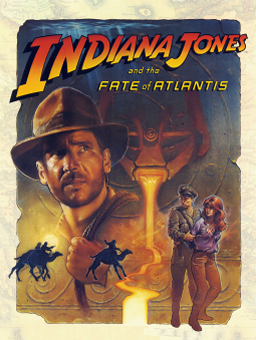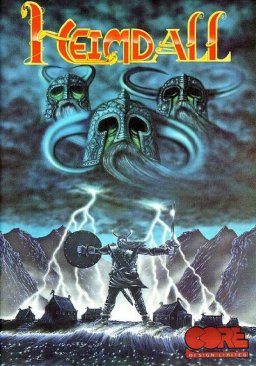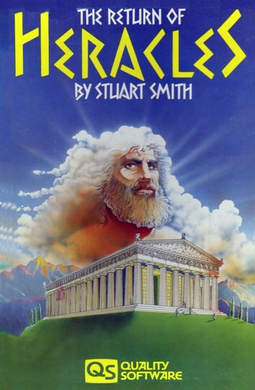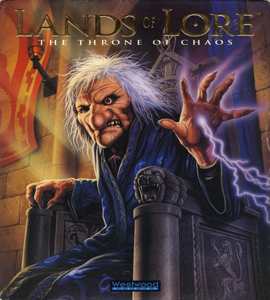A multi-user dungeon, also known as a multi-user dimension or multi-user domain, is a multiplayer real-time virtual world, usually text-based or storyboarded. MUDs combine elements of role-playing games, hack and slash, player versus player, interactive fiction, and online chat. Players can read or view descriptions of rooms, objects, other players, and non-player characters, and perform actions in the virtual world that are typically also described. Players typically interact with each other and the world by typing commands that resemble a natural language, as well as using a character typically called an avatar.

Indiana Jones and the Fate of Atlantis is a point-and-click adventure game developed and published by LucasArts and released in June 1992 for Amiga, DOS, and Macintosh. Almost a year later, it was reissued on CD-ROM as an enhanced "talkie" edition with full voice acting and digitized sound effects. The seventh game to use the script language SCUMM, Fate of Atlantis has the player explore environments and interact with objects and characters by using commands constructed with predetermined verbs. It features three unique paths to select, influencing story development, gameplay and puzzles. The game used an updated SCUMM engine and required a 286-based PC, although it still runs as a real-mode DOS application. The CD talkie version required EMS memory enabled to load the voice data.

Pool of Radiance is a role-playing video game developed and published by Strategic Simulations, Inc (SSI) in 1988. It was the first adaptation of TSR's Advanced Dungeons & Dragons (AD&D) fantasy role-playing game for home computers, becoming the first episode in a four-part series of D&D computer adventure games. The other games in the "Gold Box" series used the game engine pioneered in Pool of Radiance, as did later D&D titles such as the Neverwinter Nights online game. Pool of Radiance takes place in the Forgotten Realms fantasy setting, with the action centered in and around the port city of Phlan.

Return to Zork is a 1993 graphic adventure game in the Zork series. It was developed by Activision and was the final Zork game to be published under the Infocom label.

The Shadow of Yserbius, originally published by Sierra On-Line and developed by Joe Ybarra of Ybarra Productions, was the first of three graphical MUDs for the online community. The Shadow of Yserbius and its successors remained online until 1996, when America Online purchased the rights from AT&T for an undisclosed price. AOL soon abandoned The Shadow of Yserbius, which was a competitor to its existing online RPG Neverwinter Nights.

God of War is an action-adventure hack and slash video game developed by Santa Monica Studio and published by Sony Computer Entertainment (SCE). First released for the PlayStation 2 on March 22, 2005, the game is the first installment in the God of War series and the third chronologically. Loosely based on Greek mythology, it is set in ancient Greece with vengeance as its central motif. The player controls the protagonist Kratos, a Spartan warrior who serves the Olympian gods. The goddess Athena tasks Kratos with killing Ares, the God of War and Kratos' former mentor who tricked Kratos into killing his wife and daughter. As Ares besieges Athens out of hatred for Athena, Kratos embarks on a quest to find the one object capable of stopping the god once and for all: Pandora's Box.

Age of Mythology (AoM) is a real-time strategy video game developed by Ensemble Studios and published by Microsoft Game Studios. It was released on October 31, 2002 in North America and on November 14, 2002 in Europe.

Zeus: Master of Olympus is a single-player strategy game developed by Impressions Games and published by Sierra Studios. It is considered to be an additional installment in the City Building series of games. Like previous titles in the series, Zeus focuses on the building and development of a city in ancient times. The game features a number of changes from previous titles in the series, including being set in Ancient Greece as well as changes to certain gameplay mechanics; however, it is considered to be in most aspects very similar to its predecessor, Caesar III.

Heimdall is an action role-playing game developed by The 8th Day, published by Core Design, and released in 1991 for the Amiga and for the Atari ST and DOS in 1992, with a console version created for the Sega Mega-CD in early 1994. The game features a mixture of puzzle-solving, exploration, and dynamic combat mechanics, in which players must explore various islands in the search for the fabled weapons belonging to the gods of Norse mythology. The game received favourable reviews upon its release, though the console version was given mixed feedback by reviewers.

God of War II is an action-adventure hack and slash video game developed by Santa Monica Studio and published by Sony Computer Entertainment (SCE). First released for the PlayStation 2 on March 13, 2007, the game is the second installment in the God of War series, the sixth chronologically, and the sequel to 2005's God of War. It is based on Greek mythology and set in ancient Greece, with vengeance as its central motif. The player character is protagonist Kratos, the new God of War who killed the former, Ares. Kratos is betrayed by Zeus, the King of the Olympian gods, who strips him of his godhood and kills him. Slowly dragged to the Underworld, he is saved by the Titan Gaia, who instructs him to find the Sisters of Fate, as they can allow him to travel back in time, avert his betrayal, and take revenge on Zeus.

Al-Qadim: The Genie's Curse is an action role-playing game for the personal computer set in the Al-Qadim campaign setting of Advanced Dungeons and Dragons. The game was developed by Cyberlore Studios and published in 1994 by Strategic Simulations (SSI). The game combines role-playing game and adventure with a simplified interface; the player's character is a young corsair trying to clear his family's name, rescue his betrothed and determine who has been freeing genies from their masters.

James Michael Ward III was an American game designer and fantasy author who worked for TSR, Inc. for more than 20 years, most notably on the role-playing game Dungeons & Dragons. He wrote various books relating to Dungeons & Dragons, including guidebooks such as Deities & Demigods, and novels including Pool of Radiance, based on the computer game of the same name.

The Return of Heracles is a role-playing video game for the Atari 8-bit family, Commodore 64 and Apple II computers. It was written by Stuart Smith and published by Quality Software in 1983. Following Smith's adventure role playing games Fracas and Ali Baba and the Forty Thieves, and built on an engine that was a precursor to Adventure Construction Set, The Return of Heracles is set in the age of Greek myth and allows the player to assume the role of one or more heroes and attempt various quests.

Lands of Lore: The Throne of Chaos is a 1993 role-playing video game developed by Westwood Studios and published by Virgin Games for MS-DOS, the NEC PC-9801, and FM Towns. It was the first installment of the Lands of Lore series. The player travels around various environments, collecting items and battling monsters in an attempt to save the kingdom from a witch named Scotia, who has acquired shape-shifting abilities.

Elements of Greek mythology appear many times in culture, including pop culture. The Greek myths spread beyond the Hellenistic world when adopted into the culture of ancient Rome, and Western cultural movements have frequently incorporated them ever since, particularly since the Renaissance. Mythological elements feature in Renaissance art and in English poems, as well as in film and in other literature, and in songs and commercials. Along with the Bible and the classics-saturated works of Shakespeare, the myths of Greece and Rome have been the major "touchstone" in Western culture for the past 500 years.

God of War: Ghost of Sparta is an action-adventure hack and slash video game developed by Ready at Dawn and published by Sony Computer Entertainment (SCE). It was first released for the PlayStation Portable (PSP) handheld console on November 2, 2010. The game is the sixth installment in the God of War series and the fourth chronologically. Loosely based on Greek mythology, Ghost of Sparta is set in ancient Greece with vengeance as its central motif. The player controls the protagonist Kratos, the God of War. Kratos is still haunted by the visions of his mortal past and decides to explore his origins. In Atlantis, he finds his mother Callisto, who claims that his brother Deimos is still alive. Kratos journeys to the Domain of Death to rescue his brother. After initial resentment from Deimos, the brothers team up to battle the God of Death, Thanatos, Deimos' captor.

Disney's Animated Storybook is a point-and-click adventure interactive storybook video game series based on Walt Disney feature animations and Pixar films that were released throughout the 1990s. They were published by Disney Interactive for personal computers for children ages four to eight years old. Starting from 1994, most of the entries in the series were developed by Media Station. They have the same plots as their respective films, though abridged due to the limited medium.
Hell Cab is a 1993 adventure video game developed by Digital Fusion and published by Time Warner in 1993 for Macintosh, Windows 3.x.

Jewels of the Oracle is a 1995 adventure game developed by ELOI Productions and published by Discis Knowledge Research Inc. It was released on Macintosh, PlayStation, Sega Saturn, and Windows. A sequel developed by Bardworks and published by Hoffman and Associates was released in 1998 entitled Jewels II: The Ultimate Challenge.
Madeline is a series of educational point-and-click adventure video games which were developed during the mid-1990s for Windows and Mac systems. The games are an extension of the Madeline series of children's books by Ludwig Bemelmans, which describe the adventures of a young French girl. The video-game series was produced concurrently with a TV series of the same name, with characters and voice actors from the show.
















